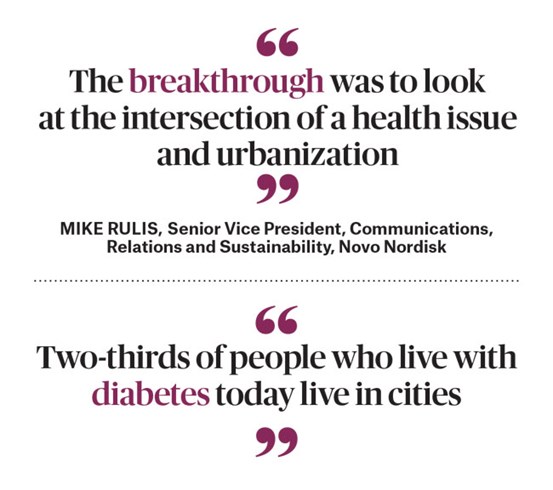Over the last few years, the company has opened up a new front line in the global fight against diabetes: cities. Two-thirds of people who live with diabetes today live in cities, and that proportion will rise as cities rise. UN statistics for 2014 reported that, for the first time ever, more than half of the world’s population live in urban areas – a number expected to climb to two-thirds by 2050.
“The breakthrough was to look at the intersection of a health issue and urbanization. That’s where the problem is most pronounced, and where we have the most to offer,” says Rulis. “It’s a new way for us to articulate the alarming rise in diabetes.”
Together with select major cities around the world, Novo Nordisk launched a campaign to start a global fight against “urban diabetes.” The campaign, Cities Changing Diabetes, debuted in Mexico City, where diabetes has been identified by the municipal authorities as the No. 1 health problem for the metropolis’ 20 million-plus residents.
The company went on to partner with Tianjin, Shanghai, Copenhagen and Houston. Together with Mexico City, these five cities have a combined population of more than 50 million.
The first challenge was clear: more data was needed. In 2014, Novo Nordisk collaborated with University College London to conduct research with leading local academic institutions in each of the cities. The innovation was to shift the focus of the research to the social and cultural factors that influence diabetes, rather than the impact of clinical interventions – and use the cities as a living lab to learn from. “If we’re to have any hope of bending the trajectory of the potentially catastrophic rise in diabetes, we have to grapple with the factors that put people at risk in the first place,” Rulis says.
The findings challenged long-held assumptions. In Houston, for example, it wasn’t just the marginalized, low-income residents who were vulnerable, but the increasingly sedentary middle-class commuters who spend up to 90 minutes driving from the suburbs to the city. Elsewhere, different factors stop people getting treated, or even tested. In Mexico, for example, the disease is often seen as a psychological issue caused by what they call “susto” – the anxiety or stress of modern life. This makes it less likely that people will prevent or manage the physical causes of the disease. In Shanghai, worry over the stigma of being diagnosed leads people to hide the condition from family and friends, limiting their access to support.
In 2015, Novo Nordisk held an unprecedented global summit in Copenhagen that brought together Cities Changing Diabetes participants from around the world. City planners and urban lifestyle experts met with healthcare professionals, city officials and patient groups to share insights and discuss solutions. More cities came on board: Vancouver, Johannesburg and Rome. And Novo Nordisk committed $20 million to take the program forward.
“Now the cities, with these insights, are starting to move to action,” Rulis says. Some are focused on policy interventions at the city level, such as a three-year plan for diabetes in Shanghai. In Copenhagen, the research identified that isolation can be a key factor, as people without work, living alone or from non-Western backgrounds are often beyond the reach of the healthcare system – and that led to the launch of a new Center for Diabetes in 2016. The city has also teamed up with Denmark’s largest trade union, 3F, to initiate a peer-group support scheme for men over the age of 45 who are “at risk.”
Most recently, the Robert Wood Johnson Foundation has awarded a three-year, $2.4 million grant to the program partner in Houston, The University of Texas Science Center (UTHealth), to establish a Healthy Cities Research Hub. The goal is that the city’s community-based model could serve as a blueprint to inspire future communities involved in the program. Novo Nordisk also partnered with C40, the global network of megacities focused on mitigating climate change, to put healthy cities on the C40 agenda – the first pilot study was published recently. “One of the reasons so many are keen to join is that this campaign is not about us,” says Rulis. “It’s about defeating diabetes, and tackling a problem that is very real for our partners.”
Through Cities Changing Diabetes, Novo Nordisk is making common cause with a host of stakeholders. “We have to forge cross-sector collaborations – partner with the leaders of health systems, engage with the people who plan and manage cities, connect with patient groups and community organizations,” says Lars Fruergaard Jørgensen, Novo Nordisk’s new CEO. “We want to be recognized not only for what we are doing, but how we are doing it.”

